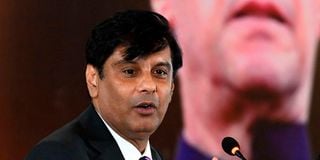Questions on ‘shot’ GSU officer as Pakistanis hand in report on Sharif

The late Pakistani journalist Arshad Sharif. He was shot dead at a police roadblock on the Nairobi-Magadi road.
An officer attached to the General Service Unit (GSU) who was allegedly shot was never questioned by a team of Pakistani investigators who were in Kenya on a fact-finding mission following the death of journalist Arshad Sharif.
In a detailed report that was handed over to the Pakistani Judiciary on Monday, December 5, two senior officials of the Federal Investigation Agency and Intelligence Bureau, Athar Waheed and Umar Shahid Hamid, said they never spoke with Mr Joseph Mutoko, who was allegedly shot from the car Sharif was in when he was shot dead by the GSU officers.
According to a statement by Kenya’s National Police Service (NPS), Sharif was in the company of Mr Khuram Ahmad who was driving him in the Landcruiser V8 from Ammo Dump Kwenia, in Kajiado County, where they had spent their day and attended a party alongside soldiers from the United States of America.
“Mr Mutoko was the only officer from the four on the spot whom the investigating team was not allowed to interview on account that he was still recovering from his injuries. Therefore, whether he was even actually wounded or not could not be independently verified,” the report read in part.
A police report released after Sharif was killed revealed that officers from the Directorate of Criminal Investigations (DCI) at the Pangani Police Station in Nairobi had called the GSU Training camp in Magadi, Kajiado County, asking for the officers to put up a roadblock in pursuit of a vehicle that had been stolen at Ngara market in Nairobi.
At the roadblock, Mr Mutoko was in the company of three other officers who have been identified as only as Sergeant Mashware, who remained in the vehicle because he was the driver, Inspector Joseph Yottea, a deputy commandant of the GSU training camp where the police officers were posted, and Mr Mathew Muendo.
Mr Muendo and Mr Mutoko then took position in a ditch as Mr Ahmad’s vehicle approached the scene where the shoot-out took place. As per the police version given to the investigating team, Mr Yottea stood by the side of the road with a flashlight.
“The police officers had set up a makeshift road block by placing rubble and stones from the side of the road, in a zig-zag pattern to force vehicles to slow down,” the report further read.
When Mr Ahmad’s vehicle approached the scene, the reports says, driver of the police vehicle “dipped his headlights with the aim of asking the vehicle to stop” but this did not happen.
It was at that point that the officers said that they heard a gunshot and Mr Mutoko shouted that he had been hit.
Despite being injured, Mr Mutoko and Mr Muendo opened fire. The Pakistani investigators said they wondered how Mr Mutoko could balance his Giboa rifle (a copy of a US M4 rifle) singlehandedly and got off three gunshots aimed at Mr Ahmad’s vehicle.
The investigating team also said they found nine bullet holes on the vehicle.
“The angle of fire on the vehicle indicates a right to left firing pattern, with the shooters firing from an angle behind the vehicle,” the report further states.
The nine bullet strikes on the vehicle were on the front tire on the driver’s side, under the door handle on the rear passenger seat behind the driver, on the rear driver’s side tire, on the top right hand corner of the rear section side window on the driver’s side (behind the passenger door) and in the middle of the left side rear side window on the driver’s side (behind the passenger door).
Others are; on the bottom left corner of the rear section side window on driver’s side, the rear lower body of the vehicle on the right side of the number plate, lower rear window on the passenger’s side and the top left hand corner of rear window on passenger's side.
The police officers told the investigating team that they had been deployed at the roadblock for one hour.
However, the investigators said there were beer cans in the bush nearby and this made them believe that the policemen had stood there for a long time.





